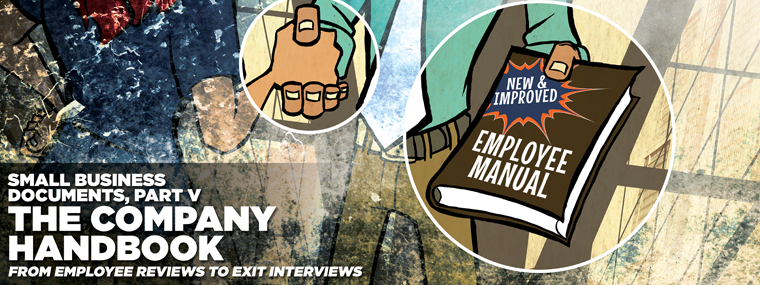
Small Business Documents, Part V, The Company Handbook, Cont. (from Employee Reviews to Exit Interviews)
By Beth Borrego / Published August 2015

Editor’s Note: Parts I, II, III, and IV were published in the April, May, June, and July 2015 issues of Cleaner Times|IWA. To read these articles in their entirety, please visit www.cleanertimes.com. This month’s article features the continuation of what elements to include in your company handbook.
Employee Reviews, Discipline, and Personal Development—use this section to outline your company’s approach to performance reviews, their frequency, who is involved in the process, and the purpose of the process. Also, outline the disciplinary process used by your company, such as verbal warnings, written warnings, and terminations. If your company conducts exit interviews, that should also be noted. If your company uses ongoing training or team building, it’s a good place to outline how they are implemented.
Code of Conduct—describe, as clearly as possible, what is deemed to be acceptable and appropriate professional behavior and that you expect this standard to be maintained at all times. Describe the disciplinary actions that may be taken should an employee fail to adhere to your company’s professional code of conduct. This is also a good place to remind employees about confidentiality, and that in the course of their employment, they may have access to confidential information, which may not be used or divulged either directly or indirectly during or after their employment. Remind them that a breach of confidentiality is a very serious matter and is grounds for discipline or termination.
You should also have a policy regarding the copyright and protection of your intellectual property. It should be known that your employees are not entitled to any of your intellectual property arising out of any work produced including, but not limited to, writing or text, graphics or images, photos or videos, or audio. It would be wise to add that employees are prohibited from capturing images or video on personal devices like cellular telephones, personal cameras, and so forth without authorization. While your business may not encounter the media very often, it doesn’t hurt to have a policy regarding giving interviews, either orally or in writing, since at some point in time, there could be an occasion where an event may warrant publicity for your company. Make sure you also mention how your company handles confidential documents and matters pertaining to their employment, as the confidentiality of your employee’s matters should be strictly confidential, and they need to know you take it seriously.
Disciplinary Action—it’s important to outline the procedures you have in place for disciplining an employee. Make sure to mention that the company may discipline any employee for actions including, but not limited to, inadequate performance, misconduct, and any breach as outlined in the employee handbook or otherwise communicated to the employee by the company. You might consider that some of the offenses may be severe enough in nature to warrant immediate termination of employment. Some of these may include, but are not limited to:
• Any material breach of your handbook
• Dishonesty or theft
• A situation that affects your business financially or affects the credit of the company
• Committing any conduct that is in direct conflict with the code of conduct outlined, and presents your company in disrepute
• Falsification of any company records, work order, time-sheets, etc.
• Willful damage to company or customer property
• Unauthorized absence from work
• Any act of violence, threat of violence, or harassment of any kind against anyone affiliated with or not affiliated with the company
• Drug or alcohol use
• Disclosing confidential information
• Unauthorized and inappropriate use of electronic media
Family and Medical Leave Act (FMLA)—it is important to become familiar with and to abide by the laws set forth in the FMLA. There is a PDF available for download that should be given to each employee and posted with other job notices. It is on the U.S. Department of Labor’s website and outlines the specifics for both men and women who are covered under this Act. Even if your company is small enough to be exempt from this Act, providing a leave benefit, paid or unpaid as your company is able, is a wonderful benefit to offer an employee who is undergoing a life-changing event.
Smoking and the Workplace—you will have to determine if your workplace is smoke-free or not, and outline the specifics of that policy. For example, is smoking allowed in the shop where materials are stored, is it allowed in company vehicles, and is it allowed on a customer’s property? Will you provide a designated smoking area at your place of business so that non-smokers may enjoy a healthier, smoke-free environment? Keep in mind that if you are a smoker others may not be, and you must think about the health and well-being of those who do not smoke, as well as those who do. If you have non-smokers among your employees, this will mean setting boundaries.
Failure to Report to Work—this is a serious offense and should stand on its own in the handbook. It should be made clear how this will be treated and what the company policy is on job abandonment. For example, you might say something like, “Any employee failing to call in to work by (fill in the time of your choice) on a day he or she is scheduled to report to work, will be deemed to have abandoned the job and voluntarily quit.”
Drug and Alcohol Policy—this may seem like a no brainer, but you must outline this policy, and make sure you enforce it. It’s a good idea to perform drug tests as a part of hiring a new employee. Even the smallest of businesses can do this with today’s home kits, but a laboratory test is still the best way to get accurate results. Make it clear in your policy that the possession or use of drugs or alcohol in the workplace is strictly prohibited and grounds for immediate dismissal. It is also important to state that any workplace injury will result in immediate drug testing. The company has a responsibility to look out for the welfare of all employees, and any employee under the influence is a potential hazard to others. Any employee who is on prescription medication, which may impair them and make them unable to work with machinery or to test positive for a specific drug, should contact their manager or the human resources department confidentially to make them aware of the situation.
Internet, E-mail, and Telephone Activity—it’s important to define your company policy on the use of the Internet, e-mail, and telephones (cellular or land lines). This helps to protect you from both criminal and civil liability from employee use. You might want to outline something in the handbook along the lines of the misuse of telephones, e-mail, and Internet that includes, but is not limited to:
• Any transmission of vulgar, abusive, defamatory, inflammatory, obscene, or racial communications
• Searching for, viewing, and downloading objectionable or pornographic material
• Viewing offensive material
• Transmitting any confidential or sensitive information about an individual or client or potential client
• Any action that would violate any state or federal law governing communications
• Any attempt to damage ordestroy any data owned by the company in connections with its business, including electronic or physical damage
Security—your employees should never give out any entry passcode or computer password. Unauthorized persons who are not employees should be prohibited from access to designated employee-only areas at the workplace, its vehicles, its job sites, and prohibited from using any equipment including but not limited to mechanical or electronic devices. Making copies of truck keys or keys to any other equipment that is key-started or of keys to any tool boxes is prohibited. Software licenses are paid for and remain the property of your company. Infringing on the license and making use of the software for your personal use should be strictly prohibited and treated as theft. Internet use and the browsing of non-work related sites should be kept to a minimum, and it is suggested that it only be done on the employee’s break or meal time. Material violating the company’s policies should not be viewed at any time. You might want to state that your company has the right to ask at any time to have access to view any online or social media account to make sure that employees are not sharing confidential information. Mobile phone use and texting may only be done during breaks, and may never be performed when operating any vehicle, tool, or equipment.
Cameras and Job Photography—your company may require that employees take photos of the work they routinely perform. Cameras supplied by the company should be for the sole use of work with the company retaining all rights to any and all electronic images, videos, and audio. These photos should include the work site before any work begins, and any anomalies, such as broken items like windows or personal effects that are in a state of disrepair should be photographed, and if the cus-
tomer is available on site, brought to their attention. After the work is completed, another set of photos taken from the same location should be taken. This not only showcases the work and lets you know how well your employees performed, but it also serves to act as proof of the conditions present before and after job completion. This protects all parties involved.
Company Benefits—List and describe any benefits you’re offering your employees, being specific about when they will become eligible to receive them. Benefits range from expensive to inexpensive, and your creativity will allow you to offer unique benefits that your employees might really enjoy and look forward to. Some of the more common benefits are sick time, vacation time, company observed holidays, and health insurance. You might also consider a safety bonus, birthday gift, or perhaps a reward based upon achieving specific goals. Many companies offer bereavement leave of three days, either paid or unpaid. You might also implement employee of the month or year and have company gatherings and events.
Exit Procedures—at some point, you’ll say goodbye to your employees, and while the hope is that your workers will be with you for many years to come, the reality is that some will not. It’s important to have a procedure in place to account for the return of all company property, equipment, tools, uniforms, and so on. You’ll also need to conduct an exit interview. Unlike the initial interview, the exit interview is specifically designed to help you to discover ways to improve your company, your working conditions, and your products and services.





